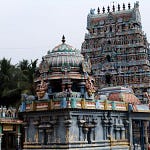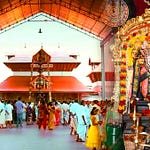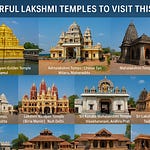Haridwar, meaning "Gateway to the Lord Vishnu," stands as a timeless city where the sacred Ganges River meets the plains of North India. Revered as one of the holiest cities in Hinduism, it draws millions of devotees, saints, and tourists annually. Haridwar's essence lies not only in its temples and rituals but also in its rich tapestry of history, heritage, and architecture, offering an experience that blends the divine with the earthly.
A Deeper Dive into Haridwar’s History
Haridwar’s history can be traced back to the Satyuga (Golden Age), mentioned in Hindu epics and Vedic texts. It is believed that King Bhagirath brought the Ganges from heaven to earth at this very spot to liberate his ancestors' souls. The city has also witnessed the footsteps of ancient sages like Kapila, Vaishnav, and Kashyapa, whose ashrams were once nestled along the riverbanks.
The historical records from the Mauryan period (322–185 BCE) reference Haridwar as a thriving city under Emperor Ashoka’s reign. Inscriptions at the Bhim Goda Tank reveal contributions from the Mauryas and the subsequent Gupta Empire, emphasizing Haridwar’s importance as a pilgrimage site and trade route.
During the medieval period, Haridwar flourished under the patronage of the Mughals and Rajput kings, with the construction of several ghats and temples. Mughal Emperor Akbar is believed to have taken water from the Ganges to his court as a symbol of purity and life.
By the time the British East India Company took control in the 19th century, Haridwar had become a critical pilgrimage center, and colonial rulers invested in infrastructure like railways to facilitate pilgrimage, boosting its accessibility.
Architectural Marvels of Haridwar
Haridwar’s architecture is a fusion of North Indian temple styles, Mughal influences, and colonial structures, representing different eras of Indian history.
Har Ki Pauri:
Built by King Vikramaditya in the 1st century BCE, this sacred ghat features ornate steps leading to the river. The Brahma Kund at Har Ki Pauri is believed to be the precise spot where Lord Vishnu’s footprint lies embedded in stone. The intricate carvings and floral motifs around the ghat exemplify ancient Indian craftsmanship.Chandi Devi Temple:
Perched atop Neel Parvat, this 8th-century temple is dedicated to Goddess Chandi. The ropeway to the temple offers aerial views of Haridwar’s landscape. The temple's stone pillars, arches, and intricate deity idols represent classic Himalayan temple architecture.Mansa Devi Temple:
Built in the 17th century, Mansa Devi Temple is located on Bilwa Parvat. The temple follows the Nagara architectural style, with its curvilinear spires (shikhara) dominating the skyline. Pilgrims tie threads around the temple’s branches, symbolizing their wishes to the goddess.Daksha Mahadev Temple:
This temple commemorates King Daksha Prajapati, Shiva’s father-in-law. The temple architecture features a blend of white marble carvings and traditional domes. Its mythological significance and unique Yagna Kund (sacrificial altar) make it a key pilgrimage site.Maya Devi Temple:
One of the Shakti Peethas (where Sati’s heart and navel fell), Maya Devi Temple is considered the heart of Haridwar. Its three-headed and four-armed idol of Goddess Maya stands as a symbol of divine energy. The temple's design reflects classical stone-carving techniques, preserving traditions from the early Gupta period.
Haridwar’s Rich Heritage
Haridwar's heritage is deeply embedded in its festivals, spiritual practices, and local traditions that have been preserved for thousands of years.
Kumbh Mela (Next in 2033):
Haridwar hosts the Kumbh Mela, the largest human gathering on earth, every 12 years. The event symbolizes spiritual purification and renewal. Millions gather to bathe in the Ganges, believing it absolves them of sins and grants moksha (liberation).Kanwar Yatra (Annual Event):
During the monsoon months, thousands of devotees, known as Kanwariyas, collect holy water from the Ganges to offer to Lord Shiva. This pilgrimage, rooted in devotion and endurance, has become an essential part of North India’s cultural landscape.Makar Sankranti and Ganga Dussehra:
These festivals celebrate the divinity of the Ganges and the transition of the sun into Capricorn. The ghats come alive with offerings, flower garlands, and rhythmic chants.
Must-Visit Places in Haridwar
Apart from temples and ghats, Haridwar offers a variety of natural and spiritual attractions:
Rajaji National Park:
Just a short drive from the city, this national park is home to elephants, tigers, and over 400 bird species. A visit to Rajaji provides a chance to witness the biodiversity of the Shivalik range.Bharat Mata Mandir:
A unique temple dedicated to Mother India, showcasing life-sized depictions of India’s freedom fighters and cultural icons.Shantikunj:
A renowned spiritual and yoga center, Shantikunj promotes Vedic teachings, yoga, and meditation retreats.Patanjali Yogpeeth:
Founded by Baba Ramdev, Patanjali Yogpeeth is a hub for Ayurveda, yoga, and holistic healing.
Why Visit Haridwar in 2025?
Haridwar is not just a pilgrimage but a transformative journey that offers peace, spiritual growth, and cultural insights. In 2025, several factors make Haridwar a must-visit:
Spiritual Rejuvenation Post-Pandemic:
After years of global unrest, Haridwar’s tranquil ghats and sacred waters provide a perfect setting for introspection and healing.Cultural Events and Festivities:
The year 2025 marks new initiatives by Uttarakhand’s tourism board to enhance festivals, fairs, and eco-tourism. Expect grand Ganga Aartis, cultural fairs, and heritage walks.Eco-Tourism and Sustainability:
Haridwar is embracing sustainable tourism, ensuring eco-friendly accommodations, plastic-free zones, and heritage preservation projects.Infrastructure Upgrades:
In 2025, ropeways, better transport facilities, and luxury hotels are expected to improve accessibility and comfort for pilgrims and tourists.
Haridwar stands as a bridge between the divine and the earthly, offering visitors a glimpse into India’s spiritual core. In 2025, the city promises not only spiritual fulfillment but also a deeper appreciation of history, heritage, and natural beauty. Whether you seek peace, cultural exploration, or adventure, Haridwar’s timeless allure awaits.










